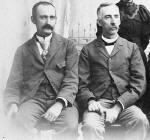|
[6,7]
E. C. Green
was a horticulturalist from Ohio, a contemporary of
A. W. Livingston, who
became well-known among certain circles for his work with tomatoes.
Mr. Green was
farming in Granger, Ohio when he met Miss Allie Relief Newton in 1882.
They were married that June 28th and remained on the farm for about seven
years. It was on this farm where the couple's eldest two children were
born.[4]
In about 1889,
the family moved to Columbus when E. C. accepted the position as an
Assistant Horticulturist at the Ohio Agricultural Experimental Station
under William J. Green, the Horticulturalist and Vice-Director. They later
resided in Wooster when the station was moved to that city.[4]

E. C. Green, left and William J. Green, right.
Ohio A. E. S. staff photo from 1895. |
While working
for the A. E. S., he authored or co-authored several articles regarding
his work. In one article describing growing tomatoes in the greenhouse, he
recognizes the qualities of 'Dwarf
Champion' and 'Potato
Leaf' tomatoes. These are the two varieties that he later crossed to
create 'Fordhook Fancy'.[4]
In 1897 the
family purchased property and moved to Medina, Ohio[2]
where he carried on his horticultural and tomato breeding work. In 1903,
Mr. Green "succeeded" the seed business of A. I. Root of Medina, Ohio
naming it E. C. Green & Son.[5]
It is
interesting to note that when he created 'Fordhook Fancy', he sold it to
W. Atlee Burpee who introduced it in 1898 as "Burpee's Fordhook Fancy."[9,10]
However, he must have retained rights to the variety as he was advertising
it for sale from his own company in print advertising. It appears that Burpee subsequently dropped the variety by 1920
and it is now presumed extinct.
Mr. Green
continued his tomato breeding work by using 'Fordhook Fancy' and crossing
it with Livingston's 'Honor
Bright'. From this crossing he selected and eventually introduced
seven new varieties in 1901 —
Green's 'Neuevo', Livingston's 'Grandus', Livingston's 'Princess',
Livingston's 'Multicolor', Livingston's 'Royal Colors', Livingston's
'Dandy Dwarf', and Livingston's 'Aristobright'[10,11,12] —all
of which seemed to have fallen out of favor and are now presumed extinct.
In 1909, the
Green's seed business merged with the Wooster Nursery Company with E. C. accepting
the position of Vice President and his son Stephen N. Green becoming
manager of the seed and greenhouse departments of the company.[6,7]
E. C. Green
passed away in 1913 and was buried in Section 4 Lot 121 of the Spring
Grove Cemetery in Medina, Ohio.[1]
Informational Sources:
-
Find-A-Grave - E. C. Green's entry.
-
Find-A-Grave - Allie Green's Entry which also include an
obituary with information about E. C. Green.
-
Find-A-Grave - Stephen N. Green's entry. Stephen, a World
War I veteran, passed
away in 1977.
-
"Tomatoes as a
Greenhouse Crop," by E. C. Green, Ohio AES Bulletin 43,
1892.
-
E. C. Green & Son
Seed Annuals for the years 1905, 1906, 1907, and 1908.
(Victory Horticultural Library)
-
Wooster Nursery Company History
-
"Seed
Trade News," The Weekly Florist's Review, January 21,
1909, p. 32.
-
"First
Generation Crosses of Tomatoes," by E. C. Green, The
Weekly Market Growers Journal, January 18, 1913, p. 4-(44).
-
Seed Annual, W.
Atlee Burpee, 1898, p. 9.
-
"An
Early Work With Mendel's Law," by E. C. Green, The
American Breeders Magazine, Vol. III, No. 1, pgs. 145-147.
-
Livingston's Seed Annual, The
Livingston Seed Company, 1901.
-
Livingston's Seeds 1902 Annual, The Livingston Seed Company,
1902.
|